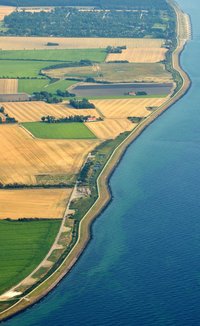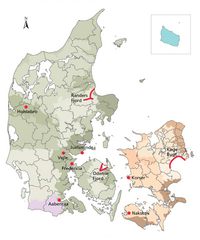- Education
-
Research
Current research
Talent
-
Collaboration
Businesses
Government agencies and institutions
Alumni
-
About AU
Organisation
Job at AU
Despite the fact that the island of Lolland has been designated one of Denmark’s ten future high-risk flood areas, homeowners here are apparently unconcerned about climate change, according to a new study from the Department of Environmental Science at Aarhus University.
2015.04.29 |

Dykes on southern Lolland protect the island’s inhabitants from frequent flooding. (Colourbox)

The ten high-risk flood areas in Denmark: Holstebro, Randers Fjord, Juelsminde, Vejle, Fredericia, Aabenraa, Odense Fjord, Køge Bay, Korsør and Naksov. The high-risk areas have been identified on the basis of an evaluation of the risk of flooding from watercourses, lakes, fjords and the sea. The list of high-risk areas was published in a2011 report from the Danish Ministry of the Environment and the Ministry of Transport.
Even though the recent violent storms Egon, Dagmar and Ole are still fresh in their memories, homeowners on Lolland are firmly convinced that their homes will be able to withstand the more frequent storms and extreme rainfall of the future. This is one of the conclusions reached by a qualitative study by sociologist Nina Baron, who asked a group of homeowners on Lolland about their perception of the risks associated with climate change and how they are acting on that risk in practice. Even though climate change presents a greater than average threat to flat, low-lying Lolland, homeowners on the island aren’t loosing any sleep over it. And the study indicates a number of reasons for this.
“It’s very much about the long history of flooding the inhabitant of Lolland have. People don’t associate these floods with climate change, and there are already pumps and dykes here that prevent the streets and cellars filling up with water every time there’s a storm,” Baron explains.
“There are indications that people with these kinds of experiences generally have a greater faith in the ability of technological solutions to continue to prevent climate change from affecting them as homeowners in high-risk areas like Lolland.”
And homeowners’ perception of how vulnerable they are to climate change is an important area to focus on.
“As things stand today, homeowners are responsible for safeguarding themselves against climate change. So it’s interesting to know how homeowners relate to the risk of flooding, and what factors either keep them from doing anything or get them to take action,” explains Baron.
Previous studies have indicated that financial aspects or the sense that one’s individual actions don’t make a difference are some of the factors that prevent people from taking active steps to reduce risk. The Lolland study shows that the situation is more complex.
“Finances can play a role. But on Lolland, it’s rather a high level of trust in technological solutions that prevents people from doing anything themselves. You might say that the current set-up with drainage systems and dykes is in fact so good that it means that people don’t have the experience of being threatened by climate change. People trust that the municipalities and government authorities will figure out new, better solutions. My research indicates that people basically need to experience being up to their knees in water before they’ll do anything themselves,” she concludes.
Copenhageners are much more concerned about climate change than Lollanders, even though the threat they face is far less immediate.
“In Copenhagen, people aren’t used to floods. So that’s why a single flood caused by torrential rains and a storm surge is enough to make people feel far more threatened by climate change,” says Baron, who has also conducted a case study in a housing cooperative in the Nørrebro district, where residents attempted to implement a local rainwater drainage project. These projects encourage homeowners to implement a variety of solutions, for example green roofs and rainwater collection systems. The goal is to avoid overloading the sewer system and begin using rainwater as a resource, for example for flushing toilets or washing clothes.
In Baron’s case, the housing cooperative’s project was put on hold for financial reasons.
“But regardless, it’s clear that their motivation for doing something is rooted in the perception of climate change as a genuine threat,” says Baron.
She views the case study as an important contribution to determining the role of homeowners in the climate change adaptation process and hopes that it may inspire additional research in the area.
The Lolland case study is based on qualitative interviews with 16 families in the towns of Nakskov and Onsevig. Homeowners were asked about what alterations they had made to their houses themselves, their experiences with flooding and their perception of living in a high-risk flood area and climate change in general. For the case study in Copenhagen, Nina Baron followed the work of the board of a housing cooperative in Nørrebro. Both studies are part of Baron’s PhD dissertation entitled “Homeowner responses to climate change – A sociological approach to climate adaptation of private homes”. The results of the Lolland project will be presented at the European climate conference ECCA on 12-14 May in Copenhagen.